15 May 2018 UN Sec. General says climate change is an 'existential threat' to most life on the planet, including and especially humankind,
VIDEO of the historic statement by UN Secretary-General António Guterres
The following record provides more evidence
of the dire, rapidly deteriorating state of the global climate emergency today
At the same time, this is the evidence of the unprecedented crime against Humanity and Nature, far beyond our 2018 book documenting the unprecedented climate crime up to that time.
As has been clear for many years, increasing climate change is a threat to the survival of the human race and most life on Earth, and 2°C is the tipping "point of no return"
Global emissions had to be in decline by 2020, to avoid 2°C and to give a slim possibility of the 1.5°C limit.
These scenarios have been pointed out since 2018 in public statements by the UN Secretary General, Antonio Guterres.
Yet today the globally disastrous 1.5°C surface warming is less than a decade away (2030/soon after) and, due to various systemic inertias, the planetary catastrophic 2°C will be reached by 2050, with global heating and its impacts continuing long after that. 2020 research finds that temperature stabilization takes decades after mitigation action.
By 2050 or 2°C (unavoidable) global climate change will force 200 million from their homes, and billions of people will be deprived on adequate food and water (IPCC 2018 1.5°C Report chart).
Global Climate change and world conflict
The most important climate science fact of all is that global emissions had to decline immediately and rapidly to avoid a warming of 1.5°C (IPCC Chair 2019), and now to avoid 2°C (IPCC Chair 2021) (since 1.5°C is now out of reach).
For energy, that means that all fossil fuels (coal, oil, gas) have to be rapidly and totally replaced by zero-carbon-combustion renewable (endless) energies. Zero carbon combustion means no biomass/wood burning for energy, and no biofuels, which are all net carbon sources (CO2 and methane/CH4).
Nothing can avoid global climate catastrophe without this rapid reduction in emissions -- no other mitigation measures, no adaptation, no CO2 removal, and certainly no artificial cooling of the planet.
Merely stopping further fossil fuel projects, and stopping the increase of greenhouse gas (GHG) emissions, cannot prevent global catastrophe.
The atmospheric GHG levels and degree of global warming are so high that all gases have to be put into rapid decline, not just CO2 (IPCC 2021).
Mitigation "solutions" can only be appreciated in today's context of globally unprecedented disastrous impacts at a now unavoidable 1.5°C and end-of-the-world feedback runaway global heating, triggered at 2°C (projected by 2050).
Warming is much higher today than in the past 10,000 years of agriculture, higher than in the past 100,000 years, and at 2°C will be higher than in the past million years.
The global climate emergency is now widely recognized and confirmed by science, yet world governments and leading national institutions are failing to take global emergency action or even call for emergency action.
Atmospheric CO2 is responsible for 65% of global heating and 100% of ocean acidification. It lasts in the atmosphere for 300 to 1000 years. Since 1750, atmospheric CO2 has increased 50% -- the highest in over 3 million years and its rate of increase 100 times faster than normal end of ice age natural warming. The rate of increase in atmospheric carbon dioxide is unprecedented over the past record going back 40 million years (WMO).
All climate system change indicators are increasing as fast as -- and several faster than -- ever, while national government policies reject any effective mitigation as they permit, subsidize and push even more fossil fuel extraction (e.g., COP26). The US EIA October 2021 states that "if current policy and technology trends continue, global energy consumption and energy-related carbon dioxide emissions will increase through 2050," projected to increase from 34 billion tonnes/year in 2020 to 43 billion a year in 2050. Today there is no prospect of this changing, and no powerful global movement to make it change.
Extreme weather events, the most dangerous climate change impacts to populations and to crops, are increasing in all regions -- driven by GHG emissions and will continue to increase in frequency and severity so long as emissions continue. That is heat waves, forest fires, drought, severe storms, and floods.
The UN (COP) climate negotiating process is set up to fail by countries instructed that consensus requires total or virtual unanimity in the voting for major matters, giving the fossil industry (via fossil pushing countries) in effect a veto over any agreement to rapidly reduce or phase out fossil fuels (as was demonstrated at COP26). So as this pertains there can be no UN agreement to rapidly reduce emissions.
WTO model free-trade agreements put profit over environmental protection and allow corporations power to sue governments (dispute process) in such issues. This is a powerful deterrent to governments acting to protect the environment.
The WTO has to correct this, putting life preserving global environmental protection above corporate profit
OCEANS GHG emissions are heating, acidifying and deoxygenating the oceans, at an accelerating rate, on track for an ocean tipping point collapse, a lethal combination for the future of all life.
2°C is planet catastrophe: At 2C (or less) the warm water coral reefs are doomed, the Amazon and tropical rainforests die-back (collapsed), most crops yields decline and runaway feedbacks RE triggered
This includes irreversible self sustaining permafrost thaw (holds 2X atmospheric carbon) , which is emitting feedback methane, CO2 and nitrous oxide ( IPCC classified three main long-lived GHGs)
The 2021 Glasgow COP 26 and rapid post Covid-19 emissions rebound shows governments have no intention of putting global emissions into decline.
Investment and financing in more fossil fuels should of course be prohibited.
Achieving a rapid large reduction in emissions is easier than realized because the vast majority of emissions is from a few countries and a few corporations.
The UN finds the country contribution of global emissions contribution of the 100 least-emitting countries is only 3%, while it is 68% from 10 largest greenhouse gas emitters. The top 3 greenhouse gas emitters contribute 16 times the emissions of the lowest emitting 100 countries. 2007 research showed emissions traced to 90 corporate carbon producers contribute ∼57% of the observed rise in atmospheric CO2, and 42–50% of the rise in global mean surface temperature. Furthermore the 2019 National Oil Company Database found national oil companies (NOCs) produce approximately 55 percent of the world’s oil and gas, pumping out an estimated 85 million barrels of oil equivalent per day. The World Bank has estimated that they control up to 90 percent of global oil and gas reserves,
Since 1990 the richest 10% of the world’s population were responsible for 52% of the cumulative carbon emissions, while The poorest 50% (3.1 billion people) were responsible for just 7% of cumulative emissions (OXFAM)
This requires a large wealth GHG pollution tax
The natural gas industry is not a bridge to zero carbon because gas emits CO2 when burnt and the industry is a big methane emitter
Fossil fuels subsidies have risen to $7 Trillion/year (IMF) an unprecedented moral evil which for the survival of Humanity have to be terminated right away and shifted to non combustion energy development
Tax credits to GHG polluting fossil fuel industries (including carbon capture storage) cannot be permitted.
CO2 and long-lived, constantly emitted GHGs accumulate in the atmosphere, so have to (can) be totally replaced by conversions to non polluting sources. That's because they accumulate in the atmosphere so long as hey are emitted, and the fossil fuel dependant polluting industries emit constantly. "Less" or "lower" is not good enough for climate and ocean stabilization.
Conversions include energy production, transport, food production/ plant-based diet, construction (steel/concrete to wood)
Air transport should revert to water, and ships powered by compact fission reactors like the US Navy (for decades). Only essential air flights.
To stabilize climate and oceans GHG emissions drop to near zero (IPCC 2014).
Surface Ozone (O3) A largely ignored but dangerous GHG is tropospheric (surface) ozone formed by a chemical reaction of fossil fuel air pollutants (incl. methane) catalyzed by lower atmosphere warmth, and so its concentration increases with global warming- which increases warming. It is toxic to human and plant health, including food crops, so will increase damage to crops as surface temperature increases. Its concentration is increasing in the northern hemisphere. Reduction of ozone precursor methane emissions will be beneficial for human and plant health.
Net zero
Unspecified net zero has now taken over emissions policy replacing actual emissions reduction on an immediate basis (IPCC AR6). As is well known the 2018 IPCC 1.5°C report showed global emissions have to reduced by 45% by 2030 (compared to 2010). This still stands as mitigation for 1.5°C- 2°C. The best case mitigation scenario of the 2018 IPCC 1.5C Report (P1) had fossil fuel emissions near zero as does the 2021 Internationals Energy Agency's 2050 net zero report. However, planned fossil fuel production by 2030 is more than double the 1.5°C limit 45% more than for 2°C (Production Gap report).
of the dire, rapidly deteriorating state of the global climate emergency today
At the same time, this is the evidence of the unprecedented crime against Humanity and Nature, far beyond our 2018 book documenting the unprecedented climate crime up to that time.
As has been clear for many years, increasing climate change is a threat to the survival of the human race and most life on Earth, and 2°C is the tipping "point of no return"
Global emissions had to be in decline by 2020, to avoid 2°C and to give a slim possibility of the 1.5°C limit.
These scenarios have been pointed out since 2018 in public statements by the UN Secretary General, Antonio Guterres.
Yet today the globally disastrous 1.5°C surface warming is less than a decade away (2030/soon after) and, due to various systemic inertias, the planetary catastrophic 2°C will be reached by 2050, with global heating and its impacts continuing long after that. 2020 research finds that temperature stabilization takes decades after mitigation action.
By 2050 or 2°C (unavoidable) global climate change will force 200 million from their homes, and billions of people will be deprived on adequate food and water (IPCC 2018 1.5°C Report chart).
Global Climate change and world conflict
Significantly the war based world economy is a major driver of global climate change
Does Climate Change Cause Conflict?
Pentagon Fuel Use
Climate Change and the Costs of War
Global climate change, war, and population decline in recent human history
Also, "climate change increases conflict ... by amplifying well-documented drivers of conflicts such as poverty and economic shocks Multiple lines of evidence relate climate variability to these forms of conflict' (IPCC 2015 AR5 WG2 SPM...19)
Significantly the war based world economy is a major driver of global climate change
Does Climate Change Cause Conflict?
Pentagon Fuel Use
Climate Change and the Costs of War
Global climate change, war, and population decline in recent human history
Also, "climate change increases conflict ... by amplifying well-documented drivers of conflicts such as poverty and economic shocks Multiple lines of evidence relate climate variability to these forms of conflict' (IPCC 2015 AR5 WG2 SPM...19)
The most important climate science fact of all is that global emissions had to decline immediately and rapidly to avoid a warming of 1.5°C (IPCC Chair 2019), and now to avoid 2°C (IPCC Chair 2021) (since 1.5°C is now out of reach).
For energy, that means that all fossil fuels (coal, oil, gas) have to be rapidly and totally replaced by zero-carbon-combustion renewable (endless) energies. Zero carbon combustion means no biomass/wood burning for energy, and no biofuels, which are all net carbon sources (CO2 and methane/CH4).
Nothing can avoid global climate catastrophe without this rapid reduction in emissions -- no other mitigation measures, no adaptation, no CO2 removal, and certainly no artificial cooling of the planet.
Merely stopping further fossil fuel projects, and stopping the increase of greenhouse gas (GHG) emissions, cannot prevent global catastrophe.
The atmospheric GHG levels and degree of global warming are so high that all gases have to be put into rapid decline, not just CO2 (IPCC 2021).
Mitigation "solutions" can only be appreciated in today's context of globally unprecedented disastrous impacts at a now unavoidable 1.5°C and end-of-the-world feedback runaway global heating, triggered at 2°C (projected by 2050).
Warming is much higher today than in the past 10,000 years of agriculture, higher than in the past 100,000 years, and at 2°C will be higher than in the past million years.
The global climate emergency is now widely recognized and confirmed by science, yet world governments and leading national institutions are failing to take global emergency action or even call for emergency action.
Atmospheric CO2 is responsible for 65% of global heating and 100% of ocean acidification. It lasts in the atmosphere for 300 to 1000 years. Since 1750, atmospheric CO2 has increased 50% -- the highest in over 3 million years and its rate of increase 100 times faster than normal end of ice age natural warming. The rate of increase in atmospheric carbon dioxide is unprecedented over the past record going back 40 million years (WMO).
All climate system change indicators are increasing as fast as -- and several faster than -- ever, while national government policies reject any effective mitigation as they permit, subsidize and push even more fossil fuel extraction (e.g., COP26). The US EIA October 2021 states that "if current policy and technology trends continue, global energy consumption and energy-related carbon dioxide emissions will increase through 2050," projected to increase from 34 billion tonnes/year in 2020 to 43 billion a year in 2050. Today there is no prospect of this changing, and no powerful global movement to make it change.
Without rapid drastic revolutionary change to the world economy, our children "face a bleak future" (worldwide) and "we will be investing in our own extinction" (UN COP26).
Youth legal appeals
It is deplorable All governments have fought the legal pleadings by youth groups for effective mitigation. In most cases the Courts have agreed with evidence, but rejected the claim- (public trust doctrine) saying it was a political, not legal matter. The fossil fuel corporations, banks governments and courts have written off the lives of today's children and all future generations.
In addition to atmospheric greenhouse pollution, is leading to 10 million deaths a year. Current government policies lead to surface heating about 3°C by 2065, and continuing higher after that. Crop yields have long been projected to be in decline for all crops in all regions at 3°C, putting fossil fuel future deaths in the billions.
Amplifying feedbacks
Major greenhouse gas sources are fossil fuel combustion, industrial age food production, with feedbacks as major potential additional catastrophic sources.
The single most catastrophic global warming effect is multiple feedback runaway climate change, a rapidly increasing risk today with emissions increasing. Yet this is not recognized as a risk by the IPCC.
There are many very large sources of amplifying (i.e., positive) feedbacks that include tipping point global warming effects. One feedback and tipping point passed is the loss of Arctic summer sea ice Since 1980 has declined 30% and its thickness by 95%. Sea ice volume (thickness) has plateaued since 2018 becasue it is almost all young thin ice that has a feedback that stabilizes it, but only for so long
Another well known tipping point and enormous feedback source is the Amazon, which is close to its tipping point, now emitting more GHGs than it absorbs, while deforestation continues apace. If deforestation is not stopped and if global emissions are not declined fast, the Amazon will be lost.
The most and the largest amplifying feedbacks are in the Arctic. Arctic permafrost alone holds double the atmospheric carbon. Arctic warming is accelerating, now warming at over three times the global rate. Rapidly thawing permafrost is releasing feedback emissions of methane, CO2 and nitrous oxide. Arctic methane (80 x CO2 effect) has a huge potential for boosting global warming. Due to Arctic feedback emissions of methane and CO2, the Arctic has switched from a carbon sink to source (NOAA 2016, confirmed 2019).
The present IPCC model projections do not include the extra warming from the large sources of amplifying feedback, calling them "uncertainties." The last IPCC assessment to address the extra warming was the 2007 4th assessment, that put extra warming at another 30% and above another 1°C by 2100. For the A2 scenario, for example, the climate-carbon cycle feedback increases the corresponding global average warming at 2100 by more than 1°C. All models that treat the coupling of the carbon cycle to climate change indicate a positive feedback effect with warming acting to suppress land and ocean uptake of CO2, leading to larger atmospheric CO2 increases and greater climate change for a given emissions scenario (AR6 Working Group 1, p.77). Climate-carbon cycle feedback, model studies suggest, add another 30% of cumulative CO2 projections (p. 16). The 2015 AR5 said feedbacks this century will be positive, i.e., amplifying. From 2021 AR6 WG1, "The fraction of emissions taken up by land and ocean is expected to decline as the CO2 concentration increases, having weakened in the past decade" (AR6 WG1 FAQ 5.1). "The net response of natural CH4 and N2O sources to future warming will be increased emissions." "Thawing terrestrial permafrost will lead to carbon release (high confidence) (IPCC AR6 WG1 Ch 4).
Youth legal appeals
It is deplorable All governments have fought the legal pleadings by youth groups for effective mitigation. In most cases the Courts have agreed with evidence, but rejected the claim- (public trust doctrine) saying it was a political, not legal matter. The fossil fuel corporations, banks governments and courts have written off the lives of today's children and all future generations.
In addition to atmospheric greenhouse pollution, is leading to 10 million deaths a year. Current government policies lead to surface heating about 3°C by 2065, and continuing higher after that. Crop yields have long been projected to be in decline for all crops in all regions at 3°C, putting fossil fuel future deaths in the billions.
Amplifying feedbacks
Major greenhouse gas sources are fossil fuel combustion, industrial age food production, with feedbacks as major potential additional catastrophic sources.
The single most catastrophic global warming effect is multiple feedback runaway climate change, a rapidly increasing risk today with emissions increasing. Yet this is not recognized as a risk by the IPCC.
There are many very large sources of amplifying (i.e., positive) feedbacks that include tipping point global warming effects. One feedback and tipping point passed is the loss of Arctic summer sea ice Since 1980 has declined 30% and its thickness by 95%. Sea ice volume (thickness) has plateaued since 2018 becasue it is almost all young thin ice that has a feedback that stabilizes it, but only for so long
Another well known tipping point and enormous feedback source is the Amazon, which is close to its tipping point, now emitting more GHGs than it absorbs, while deforestation continues apace. If deforestation is not stopped and if global emissions are not declined fast, the Amazon will be lost.
The most and the largest amplifying feedbacks are in the Arctic. Arctic permafrost alone holds double the atmospheric carbon. Arctic warming is accelerating, now warming at over three times the global rate. Rapidly thawing permafrost is releasing feedback emissions of methane, CO2 and nitrous oxide. Arctic methane (80 x CO2 effect) has a huge potential for boosting global warming. Due to Arctic feedback emissions of methane and CO2, the Arctic has switched from a carbon sink to source (NOAA 2016, confirmed 2019).
The present IPCC model projections do not include the extra warming from the large sources of amplifying feedback, calling them "uncertainties." The last IPCC assessment to address the extra warming was the 2007 4th assessment, that put extra warming at another 30% and above another 1°C by 2100. For the A2 scenario, for example, the climate-carbon cycle feedback increases the corresponding global average warming at 2100 by more than 1°C. All models that treat the coupling of the carbon cycle to climate change indicate a positive feedback effect with warming acting to suppress land and ocean uptake of CO2, leading to larger atmospheric CO2 increases and greater climate change for a given emissions scenario (AR6 Working Group 1, p.77). Climate-carbon cycle feedback, model studies suggest, add another 30% of cumulative CO2 projections (p. 16). The 2015 AR5 said feedbacks this century will be positive, i.e., amplifying. From 2021 AR6 WG1, "The fraction of emissions taken up by land and ocean is expected to decline as the CO2 concentration increases, having weakened in the past decade" (AR6 WG1 FAQ 5.1). "The net response of natural CH4 and N2O sources to future warming will be increased emissions." "Thawing terrestrial permafrost will lead to carbon release (high confidence) (IPCC AR6 WG1 Ch 4).
Extreme weather events, the most dangerous climate change impacts to populations and to crops, are increasing in all regions -- driven by GHG emissions and will continue to increase in frequency and severity so long as emissions continue. That is heat waves, forest fires, drought, severe storms, and floods.
Global warming and climate change are accelerating. J. Hansen, WMO
The 2020 emissions deadline has passed --and the 1.5°C limit. James Hansen, global temperature Dec 2021, Jan 2022
Global emissions had to be in decline by 2020 for 1.5°C and 2°C.
At 1.5°C and above, with increasing climate change and increasing extreme weather events, projections indicate harm to crops and loss of world food security (pdf).
Global warming and climate change are accelerating. J. Hansen, WMO
The 2020 emissions deadline has passed --and the 1.5°C limit. James Hansen, global temperature Dec 2021, Jan 2022
Global emissions had to be in decline by 2020 for 1.5°C and 2°C.
At 1.5°C and above, with increasing climate change and increasing extreme weather events, projections indicate harm to crops and loss of world food security (pdf).
Increasing global emissions today are on track, to a planet catastrophic 2°C, harming and taking the lives of billions by 2050 (IPCC)
The 2015 Paris Agreement only requires countries to report their GHG emissions. The goal of "Holding the increase in the global average temperature to well below 2°C above pre-industrial levels and pursuing efforts to limit the temperature increase to 1.5°C above pre-industrial levels" is voluntary, but it (hold) does not allow overshooting 2°C, as in assessments.
The 2015 Paris Agreement only requires countries to report their GHG emissions. The goal of "Holding the increase in the global average temperature to well below 2°C above pre-industrial levels and pursuing efforts to limit the temperature increase to 1.5°C above pre-industrial levels" is voluntary, but it (hold) does not allow overshooting 2°C, as in assessments.
The UN (COP) climate negotiating process is set up to fail by countries instructed that consensus requires total or virtual unanimity in the voting for major matters, giving the fossil industry (via fossil pushing countries) in effect a veto over any agreement to rapidly reduce or phase out fossil fuels (as was demonstrated at COP26). So as this pertains there can be no UN agreement to rapidly reduce emissions.
WTO model free-trade agreements put profit over environmental protection and allow corporations power to sue governments (dispute process) in such issues. This is a powerful deterrent to governments acting to protect the environment.
The WTO has to correct this, putting life preserving global environmental protection above corporate profit
OCEANS GHG emissions are heating, acidifying and deoxygenating the oceans, at an accelerating rate, on track for an ocean tipping point collapse, a lethal combination for the future of all life.
2°C is planet catastrophe: At 2C (or less) the warm water coral reefs are doomed, the Amazon and tropical rainforests die-back (collapsed), most crops yields decline and runaway feedbacks RE triggered
This includes irreversible self sustaining permafrost thaw (holds 2X atmospheric carbon) , which is emitting feedback methane, CO2 and nitrous oxide ( IPCC classified three main long-lived GHGs)
The 2021 Glasgow COP 26 and rapid post Covid-19 emissions rebound shows governments have no intention of putting global emissions into decline.
In its 2019 Gap Report UNEP stated a 7.6% emissions reduction every year between 2020 and 2030, was required to limit global warming to 1.5°C (this century), so this certainly still applies for 2°C equilibrium limit. 10 years to de-carbonization is the fastest published. -in 2016. Because relatively few countries and few corporations emit most of the emissions a rapid emissions reduction is more feasible than is realized (see section below).
In its 2019 Gap Report UNEP stated a 7.6% emissions reduction every year between 2020 and 2030, was required to limit global warming to 1.5°C (this century), so this certainly still applies for 2°C equilibrium limit. 10 years to de-carbonization is the fastest published. -in 2016. Because relatively few countries and few corporations emit most of the emissions a rapid emissions reduction is more feasible than is realized (see section below).
Continued current emissions and policies lead to biosphere collapse with climate and oceans catastrophe
Another reason why rapid emissions reduction is feasible is that simple corrections to the world economics would reverse emissions in short order. The fact that zero carbon energy is now cost competitive with fossil fuels and the sensitivity and power of the market means that Simply the immediate termination of the huge fossil fuel subsides would do so.
Economics
The root causes of the global emergency are, the world consumer market economy, government subsidies, investment banks and managers, and consumerism. The 2006 UK Stern Commission The Economics of Climate Change made it clear the cause of climate change is today's economy. Fundamental fatal flaws or errors of economics is causing greenhouse pollution, called market failures by the economists. There is no stopping climate change without first fixing the economics- correcting the market failures. As Stern said over and over "First put a price on carbon".
Another reason why rapid emissions reduction is feasible is that simple corrections to the world economics would reverse emissions in short order. The fact that zero carbon energy is now cost competitive with fossil fuels and the sensitivity and power of the market means that Simply the immediate termination of the huge fossil fuel subsides would do so.
Economics
The root causes of the global emergency are, the world consumer market economy, government subsidies, investment banks and managers, and consumerism. The 2006 UK Stern Commission The Economics of Climate Change made it clear the cause of climate change is today's economy. Fundamental fatal flaws or errors of economics is causing greenhouse pollution, called market failures by the economists. There is no stopping climate change without first fixing the economics- correcting the market failures. As Stern said over and over "First put a price on carbon".
Investment and financing in more fossil fuels should of course be prohibited.
Achieving a rapid large reduction in emissions is easier than realized because the vast majority of emissions is from a few countries and a few corporations.
The UN finds the country contribution of global emissions contribution of the 100 least-emitting countries is only 3%, while it is 68% from 10 largest greenhouse gas emitters. The top 3 greenhouse gas emitters contribute 16 times the emissions of the lowest emitting 100 countries. 2007 research showed emissions traced to 90 corporate carbon producers contribute ∼57% of the observed rise in atmospheric CO2, and 42–50% of the rise in global mean surface temperature. Furthermore the 2019 National Oil Company Database found national oil companies (NOCs) produce approximately 55 percent of the world’s oil and gas, pumping out an estimated 85 million barrels of oil equivalent per day. The World Bank has estimated that they control up to 90 percent of global oil and gas reserves,
Since 1990 the richest 10% of the world’s population were responsible for 52% of the cumulative carbon emissions, while The poorest 50% (3.1 billion people) were responsible for just 7% of cumulative emissions (OXFAM)
This requires a large wealth GHG pollution tax
The natural gas industry is not a bridge to zero carbon because gas emits CO2 when burnt and the industry is a big methane emitter
Fossil fuels subsidies have risen to $7 Trillion/year (IMF) an unprecedented moral evil which for the survival of Humanity have to be terminated right away and shifted to non combustion energy development
Tax credits to GHG polluting fossil fuel industries (including carbon capture storage) cannot be permitted.
CO2 and long-lived, constantly emitted GHGs accumulate in the atmosphere, so have to (can) be totally replaced by conversions to non polluting sources. That's because they accumulate in the atmosphere so long as hey are emitted, and the fossil fuel dependant polluting industries emit constantly. "Less" or "lower" is not good enough for climate and ocean stabilization.
Conversions include energy production, transport, food production/ plant-based diet, construction (steel/concrete to wood)
Air transport should revert to water, and ships powered by compact fission reactors like the US Navy (for decades). Only essential air flights.
To stabilize climate and oceans GHG emissions drop to near zero (IPCC 2014).
Surface Ozone (O3) A largely ignored but dangerous GHG is tropospheric (surface) ozone formed by a chemical reaction of fossil fuel air pollutants (incl. methane) catalyzed by lower atmosphere warmth, and so its concentration increases with global warming- which increases warming. It is toxic to human and plant health, including food crops, so will increase damage to crops as surface temperature increases. Its concentration is increasing in the northern hemisphere. Reduction of ozone precursor methane emissions will be beneficial for human and plant health.
Net zero
Unspecified net zero has now taken over emissions policy replacing actual emissions reduction on an immediate basis (IPCC AR6). As is well known the 2018 IPCC 1.5°C report showed global emissions have to reduced by 45% by 2030 (compared to 2010). This still stands as mitigation for 1.5°C- 2°C. The best case mitigation scenario of the 2018 IPCC 1.5C Report (P1) had fossil fuel emissions near zero as does the 2021 Internationals Energy Agency's 2050 net zero report. However, planned fossil fuel production by 2030 is more than double the 1.5°C limit 45% more than for 2°C (Production Gap report).
Only ZERO CARBON COMBUSTION can stabilize atmospheric CO2 (and ocean acidification), so fossil fuel extraction has to stop right away and be phased out fast (fossilfueltreaty)
Stop fossil fuel (and biomass) combustion in 10 yrs
A full-cost carbon pollution fee is required fast increasing to $200/tonne), charged to the central large polluting coporations, and invested in non-combustion energy
Zero future discounting has to apply In matters of GHG pollution impacts
Make investment in zero carbon combustion energy tax deductible
The only non GHG polluting energy-dense power source ate large world wide scale alternative to coal (for heavy industry) at present is nuclear fission (concentrated solar thermal in theory), so fission plants cannot be closed (can be refurbished) and safe molten salt compact reactors produced in large numbers to replace industrial coal and natural gas.
Limiting to 2°C requires very large, very long term removal of CO2 from the air. The only safe certain CO2 known is removal by direct air extraction (DAC) that requires energy. This requites a massive Manhattan Project type R&D venture. Even then models project a lag of 30 years from CO2 removal to stabilization of atmospheric CO2 (IPCC AR6 WG1)
So there is no allowable carbon budget left to burn more fossil fuels
Net zero emissions and carbon neutral have to include zero fossil fuels and zero carbon combustion. The undefined net zero by 2050 today is being used as reason to not reduce emissions rapidly, nor to near zero (even oil corporations say they will be net zero by 2050)
Net zero means no biomass burning, even assuming carbon capture and storage (CCS). CCS after decades of attempts and government financing remains unproven, so CCS (or promise of CCS) cannot possibly be an assumed mitigation
Carbon neutral, net zero, carbon offsetting and carbon trading are ways of delaying and avoiding emergency immediate slashing of emissions
Clearing forests is not net zero or carbon neutral, as clearing and burning emit forest floor and slash carbon, and it takes 25 years for a new forest to pull out carbon. Today when global emissions had to be declining, clear cutting forests is a carbon emitter.
Zero deforestation is required for de-carbonization (no clear cutting)
De-militarization with international peaceful co-operation is a pre-requisite for de-carbonization. World military expenditures are increasing, now almost two and a half trillion USD a year.
Budgets and expertise would be transferred for large mitigation and adaptation projects.
The livestock/meat and dairy industry have to end for near zero methane and CO2 emissions (IPCC AR5) because cattle exhale methane and forests are cleared for pasture and cattle feed (CO2)
The world has to go vegan, the least GHG polluting, healthiest diet after all.
Highly potent long lasting F-gases (halocarbons) have to be eliminated.
Geo-engineering
As catastrophe looms larger due to inaction, more attention from the science and government is being given to geo engineering planetary cooling. This has always been extremely dangerous to our future survival because it has provided a false excuse for inaction on emissions.
Obviously it cannot be resorted to in the absence of aggressive mitigation, but it is looking like it will be. Expect governments to launch cooling while fossil fuels continue emitting. Some CO2 has to be removed safely by direct air capture, but the feasible amount at best would be limited. BECCS is ecologically and social justice obscene, and would fail.
All future are for continued global suicidal fossuel dominated energy. This is an unprecedented failure
Fact today is we to remove enormous quantities of CO2, but have no science or technology to do any CO2 removal at scale, so we need a carbon R&D Manhattan project. We have to maximize new safe CO2 removal to minimize amount and duration of planet cooling.
Panet cooling cannot mitigate catastrophic climate change, at best provide a short delay. The reasons are the oceans. Ocean acidification would continue, which alone can be catastrophic in the oceans and so to life on land. There is such gargantuan heat in the ocean, more going deeper all the time. Cooling would brely though would barel change that The other major reason is that atmospheric GHGs would continue to accumulate in the atmosphere increasing the radiative heat forcing. Sea level rise would continue. Whenever the cooling stops an abrupt massive global heating is the result, which would be the end for almost all life.
Regional Arctic cooling should be tested (now) to retain sea ice and stabilize Arctic carbon
Only ZERO CARBON COMBUSTION can stabilize atmospheric CO2 (and ocean acidification), so fossil fuel extraction has to stop right away and be phased out fast (fossilfueltreaty)
Stop fossil fuel (and biomass) combustion in 10 yrs
A full-cost carbon pollution fee is required fast increasing to $200/tonne), charged to the central large polluting coporations, and invested in non-combustion energy
Zero future discounting has to apply In matters of GHG pollution impacts
Make investment in zero carbon combustion energy tax deductible
The only non GHG polluting energy-dense power source ate large world wide scale alternative to coal (for heavy industry) at present is nuclear fission (concentrated solar thermal in theory), so fission plants cannot be closed (can be refurbished) and safe molten salt compact reactors produced in large numbers to replace industrial coal and natural gas.
Limiting to 2°C requires very large, very long term removal of CO2 from the air. The only safe certain CO2 known is removal by direct air extraction (DAC) that requires energy. This requites a massive Manhattan Project type R&D venture. Even then models project a lag of 30 years from CO2 removal to stabilization of atmospheric CO2 (IPCC AR6 WG1)
So there is no allowable carbon budget left to burn more fossil fuels
Net zero emissions and carbon neutral have to include zero fossil fuels and zero carbon combustion. The undefined net zero by 2050 today is being used as reason to not reduce emissions rapidly, nor to near zero (even oil corporations say they will be net zero by 2050)
Net zero means no biomass burning, even assuming carbon capture and storage (CCS). CCS after decades of attempts and government financing remains unproven, so CCS (or promise of CCS) cannot possibly be an assumed mitigation
Carbon neutral, net zero, carbon offsetting and carbon trading are ways of delaying and avoiding emergency immediate slashing of emissions
Clearing forests is not net zero or carbon neutral, as clearing and burning emit forest floor and slash carbon, and it takes 25 years for a new forest to pull out carbon. Today when global emissions had to be declining, clear cutting forests is a carbon emitter.
Zero deforestation is required for de-carbonization (no clear cutting)
De-militarization with international peaceful co-operation is a pre-requisite for de-carbonization. World military expenditures are increasing, now almost two and a half trillion USD a year.
Budgets and expertise would be transferred for large mitigation and adaptation projects.
The livestock/meat and dairy industry have to end for near zero methane and CO2 emissions (IPCC AR5) because cattle exhale methane and forests are cleared for pasture and cattle feed (CO2)
The world has to go vegan, the least GHG polluting, healthiest diet after all.
Highly potent long lasting F-gases (halocarbons) have to be eliminated.
Geo-engineering
As catastrophe looms larger due to inaction, more attention from the science and government is being given to geo engineering planetary cooling. This has always been extremely dangerous to our future survival because it has provided a false excuse for inaction on emissions.
Obviously it cannot be resorted to in the absence of aggressive mitigation, but it is looking like it will be. Expect governments to launch cooling while fossil fuels continue emitting. Some CO2 has to be removed safely by direct air capture, but the feasible amount at best would be limited. BECCS is ecologically and social justice obscene, and would fail.
All future are for continued global suicidal fossuel dominated energy. This is an unprecedented failure
Fact today is we to remove enormous quantities of CO2, but have no science or technology to do any CO2 removal at scale, so we need a carbon R&D Manhattan project. We have to maximize new safe CO2 removal to minimize amount and duration of planet cooling.
Panet cooling cannot mitigate catastrophic climate change, at best provide a short delay. The reasons are the oceans. Ocean acidification would continue, which alone can be catastrophic in the oceans and so to life on land. There is such gargantuan heat in the ocean, more going deeper all the time. Cooling would brely though would barel change that The other major reason is that atmospheric GHGs would continue to accumulate in the atmosphere increasing the radiative heat forcing. Sea level rise would continue. Whenever the cooling stops an abrupt massive global heating is the result, which would be the end for almost all life.
Regional Arctic cooling should be tested (now) to retain sea ice and stabilize Arctic carbon
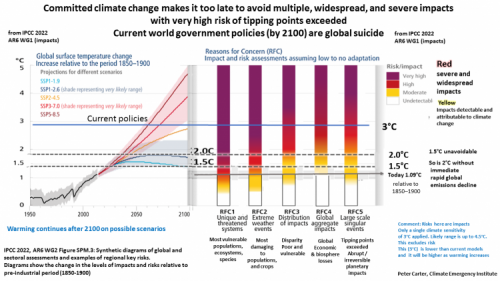
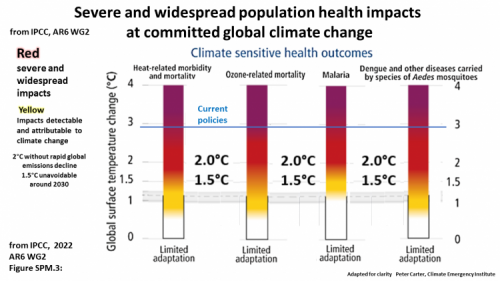
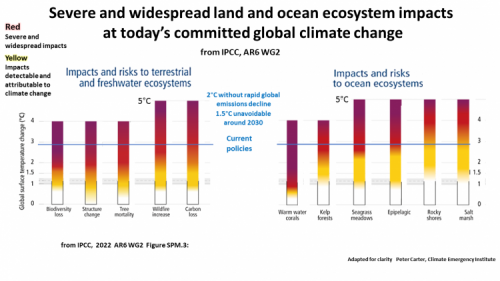
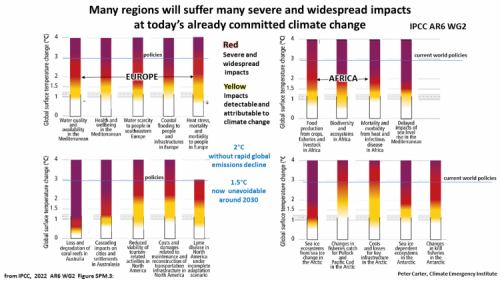
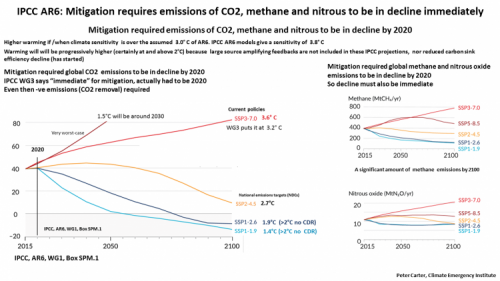
Commitment can be estimated from atmospheric greenhouse gas concentrations (CO2 equivalent) and radiative forcing
NOAA AGGI May 2022
Atmospheric CO2 equivalent (all GHGs) increased 33% from 1980 (508 ppm).
Radiative heat forcing tripled.
NOAA AGGI May 2022
Atmospheric CO2 equivalent (all GHGs) increased 33% from 1980 (508 ppm).
Radiative heat forcing tripled.
Global disastrous fixed 1.5°C 2030 or soon after and 2°C by 2050
“In all mitigation scenarios, crossing the 1.5°C threshold lies
in the early 2030s” 2°C is crossed by 2050 (IPCC AR6 WG1 Ch.4-555)
“In all mitigation scenarios, crossing the 1.5°C threshold lies
in the early 2030s” 2°C is crossed by 2050 (IPCC AR6 WG1 Ch.4-555)
UNEP
Climate Emergency
Climate Emergency
Atmospheric CO2: 423.9 ppm
April 2024 NOAA mean CO2
Also NOAA has atmospheric methane & nitrous oxide same site
April 2024 NOAA mean CO2
Also NOAA has atmospheric methane & nitrous oxide same site
Unprecedented atmospheric CO2 rate of increase
Highest in 14 million years. Rate of increase 56 million year high
The rate at which CO2 has increased in the atmosphere during 1900–2019 is at least 10 times faster than at any other time during the last 800,000 years, and 4–5 times faster than during the last 56 million years (IPCC AR6, WG1, 5-676)
Highest in 14 million years. Rate of increase 56 million year high
The rate at which CO2 has increased in the atmosphere during 1900–2019 is at least 10 times faster than at any other time during the last 800,000 years, and 4–5 times faster than during the last 56 million years (IPCC AR6, WG1, 5-676)
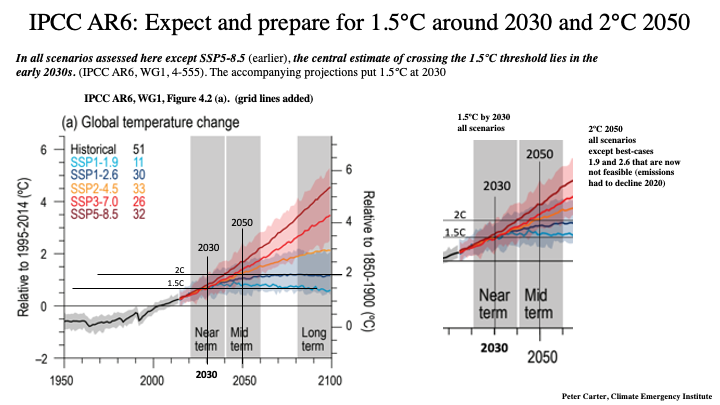
2021 atmospheric CO2 equivalent (all GHGs)
Record global greenhouse gas emissions
Record global greenhouse gas emissions
2023 Global Carbon Project
Record and increasing fossil fuel CO2 emissions (2023)
Also Carbon sink efficiency is declining: land 20% Ocean 7%
Record and increasing fossil fuel CO2 emissions (2023)
Also Carbon sink efficiency is declining: land 20% Ocean 7%
WMO atmospheric GHGs in 2023 Record atmospheric greenhouse concentrations-all increasing at accelerating rates
Record world fossil fuel consumption 2022
IPCC 6th Assessment (AR6)
IPCC Reasons for Concern Risks/impacts
The 'burning embers' IPCC formulation of risks/impacts.
The global warming at which impacts occur in AR6 is much lower than the 2014 IPCC AR5, as research has found impacts occur at lower degrees
The 'burning embers' IPCC formulation of risks/impacts.
The global warming at which impacts occur in AR6 is much lower than the 2014 IPCC AR5, as research has found impacts occur at lower degrees
Climate Change Commitment is unavoidable increased climate change
Over 2°C committed warming is committed
By radiative (heat) forcing commitment is at least 2.4°C
Nov. 2023, James Hansen et al Warming in the pipeline
VIDEO 2021 paper Committed warming from past emissions alone is 1.4°C and with cloud feedbacks commitment is 2.5°C. Dept Energy report on the paper
Nature published paper
Over 2°C committed warming is committed
By radiative (heat) forcing commitment is at least 2.4°C
Nov. 2023, James Hansen et al Warming in the pipeline
VIDEO 2021 paper Committed warming from past emissions alone is 1.4°C and with cloud feedbacks commitment is 2.5°C. Dept Energy report on the paper
Nature published paper
Record Global warming 2023
is at 1.45°C by WMO
(1.48°C here) Highest in 125,000 yrs and
by a record increase
Temperature updates (see below CO2)
is at 1.45°C by WMO
(1.48°C here) Highest in 125,000 yrs and
by a record increase
Temperature updates (see below CO2)
CO2 Earth Atmospheric CO2 at record high, increasing at an accelerating rate
On Current policies Warming will be 3.2°C this century (IPCC AR6) Higher after 2100
For 1.5°C & 2°C emissions had to be in decline by 2020, now (immediate) (AR6)
IPCC temperature increases are only to 2100.
Warming continues 100s of years after 2100
Warming continues 100s of years after 2100
Negative emissions
CO2 removal is required for 1.5°C & 2°C, and is assumed in model projection to be feasible- successful for enormous amounts of CO2, continued at least a hundred years. Net-zero carbon emissions for mitigation relies on large CO2 removal, increasing every year of delay.
No such capacity exists today. This cannot be relied on and the amount is not feasible without rapid emissions decline. Negative emissions only applies to CO2 and cannot compensate for continuing other GHG emissions, as is stated for mitigation by IPCC.
CO2 removal is required for 1.5°C & 2°C, and is assumed in model projection to be feasible- successful for enormous amounts of CO2, continued at least a hundred years. Net-zero carbon emissions for mitigation relies on large CO2 removal, increasing every year of delay.
No such capacity exists today. This cannot be relied on and the amount is not feasible without rapid emissions decline. Negative emissions only applies to CO2 and cannot compensate for continuing other GHG emissions, as is stated for mitigation by IPCC.
Record Highs While emissions had to be declining by 2020 (for 1.5°C & 2°C), greenhouse gas emissions and atmospheric concentrations are record high, increasing as fast as ever.
The same applies to ocean effects
The same applies to ocean effects
2018 IPCC 1.5°C Report showed 1.5°C on impacts is globally disastrous and 2°C globally catastrophic- obvious now from unprecedented extreme events all regions.
UNEP GAP Reports (and all climate science) for many years has shown global emissions must decline by 2020 (very latest)
IPCC AR6 emissions projections
Climate change is not reversible (without successful CO2 removal- not feasible for many years) Possibly nothing is more dangerous than to think it is.
Ocean changes are not reversible. 'Past GHG emissions since 1750 have committed the global ocean to future warming- will continue to increase. Changes are irreversible on centennial to millennial time scales' (IPCC AR6 WG1 B.5.1). Committed future warming is always much higher than current warming because of he very long atmospheric lifetime of CO2 the huge ocean heat increase, and climate change today is irreversible (e.g. Irreversible climate change due to CO2 emissions.)
Sea level rise will increase over many 100s of years
Sea level rise will increase over many 100s of years
Governments (by record fossil fuel subsidies), banks and industry are INCREASING fossil fuel production as fast as ever.
This leads to a hard to live future climate for the whole world- that is now certain, and an unliveable future most likely.
At 2°C (or less) multiple large global warming amplifying feedbacks, and tipping points are triggered
The IPCC AR6 told us all extreme weather events are
increasing,due to human emissions, and will continue increasing
with every increment of global warming
increasing,due to human emissions, and will continue increasing
with every increment of global warming
IPCC AR6 Global temperature increase projections
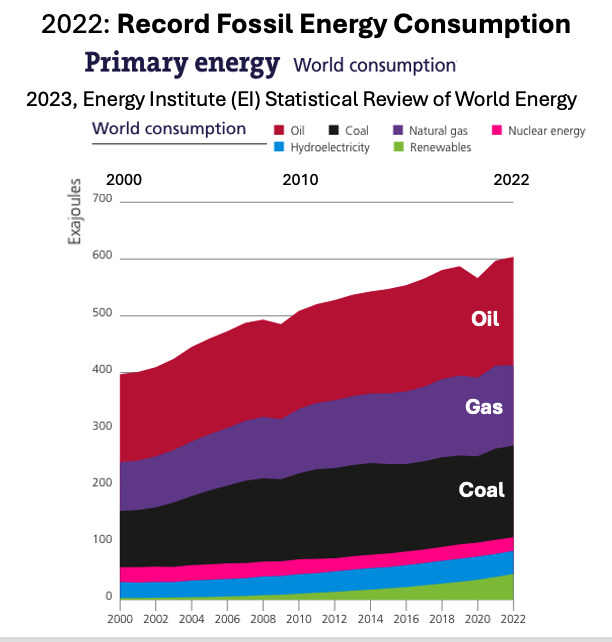
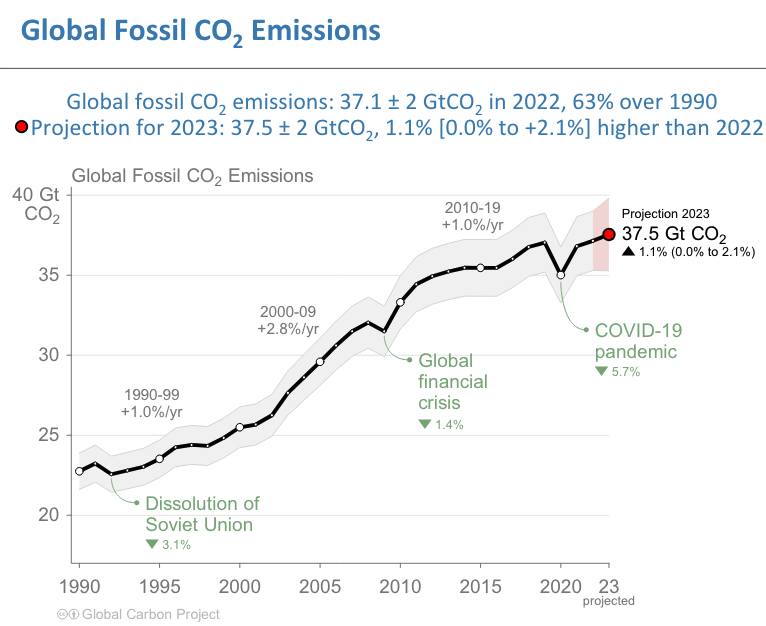
CHILDREN
Small children are most vulnerable to all climate change impacts, in all regions,
though most vulnerable in lpw latitiudes and Africa
though most vulnerable in lpw latitiudes and Africa
Committment or unavoidable warming is key in assessing risks, impacts and the emergency
The most recent estimate is 2.4°C by 2100 (James Hansen et al, Global warming in the pipeline, Nov. 2023) This derives from radiative (heat) forcing
"Warming still in the pipeline for 3 W/m2 forcing is 2.4°C, exceeding warming realized to date (1.2°C). Slow feedbacks increase the equilibrium response even further"
The most recent estimate is 2.4°C by 2100 (James Hansen et al, Global warming in the pipeline, Nov. 2023) This derives from radiative (heat) forcing
"Warming still in the pipeline for 3 W/m2 forcing is 2.4°C, exceeding warming realized to date (1.2°C). Slow feedbacks increase the equilibrium response even further"
Atmospheric greenhouse gas concentrations
in 2023 (WMO, March 2024)
All record high increasing at accelerating rates
in 2023 (WMO, March 2024)
All record high increasing at accelerating rates
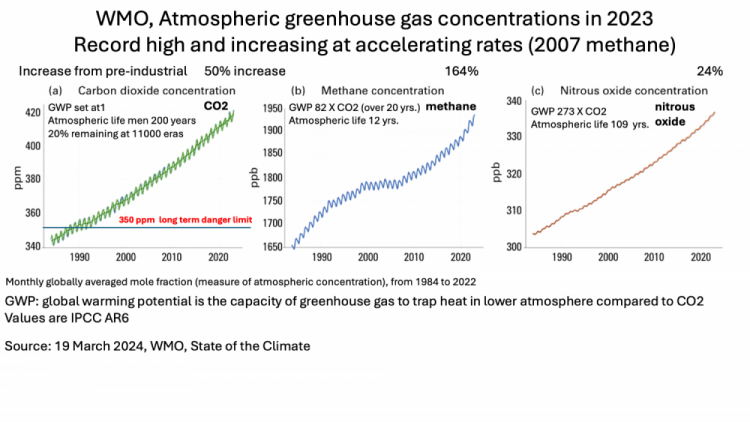
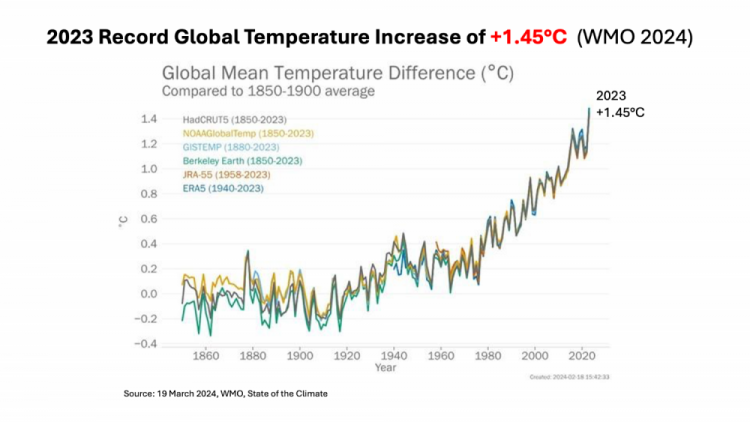
World's children, most vulnerable,
will be devastated
will be devastated
You can scroll down this long single page for the main information

Climate Emergency Institute

click on image for full size clear images
State of the Climate in 2023, WMO March 2024: WMO sounded a Red 'Alert on climate change worldwide' Annual report on the state of the global climate, confirms 2023 was the hottest ever recorded for 174 years (by far)
'Records were again broken, and in some cases smashed, for greenhouse gas levels, surface temperatures, ocean heat and acidification, sea level rise, Antarctic Sea ice cover, and glacier retreat'.
The report emphasised that 'warming is expected to continue—a change which is irreversible on scales of hundreds to thousands of years'.
'Records were again broken, and in some cases smashed, for greenhouse gas levels, surface temperatures, ocean heat and acidification, sea level rise, Antarctic Sea ice cover, and glacier retreat'.
The report emphasised that 'warming is expected to continue—a change which is irreversible on scales of hundreds to thousands of years'.
IPCC AR6 emissions (Gt CO2/year) scenario projections and corresponding global warming to 2100
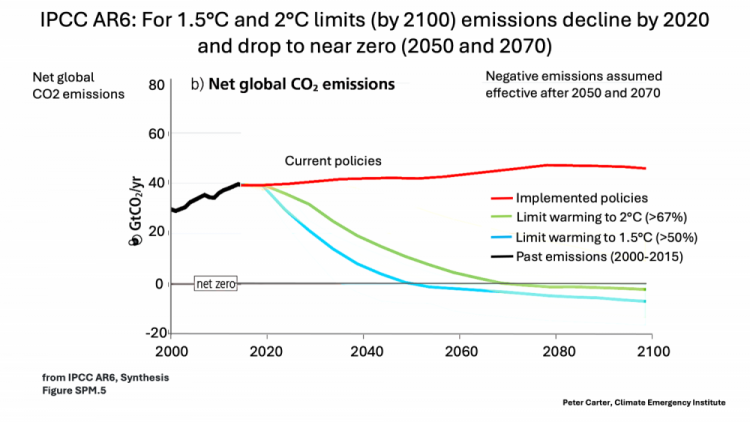
WMO: 'Sea levels rose more than twice as fast from 2014 to 2023 than the decade 1993 to 2002.
Antarctic sea ice in February 2023, was the lowest ever recorded. Glacier melt is unprecedented.
On an average day in 2023, nearly one third of the global ocean was gripped by a marine heatwave, harming vital ecosystems and food systems. Near the end of 2023, over 90% of the ocean had had heatwave conditions during the year.
Antarctic sea ice in February 2023, was the lowest ever recorded. Glacier melt is unprecedented.
On an average day in 2023, nearly one third of the global ocean was gripped by a marine heatwave, harming vital ecosystems and food systems. Near the end of 2023, over 90% of the ocean had had heatwave conditions during the year.

WMO 2024
State of the Climate
in 2023
State of the Climate
in 2023
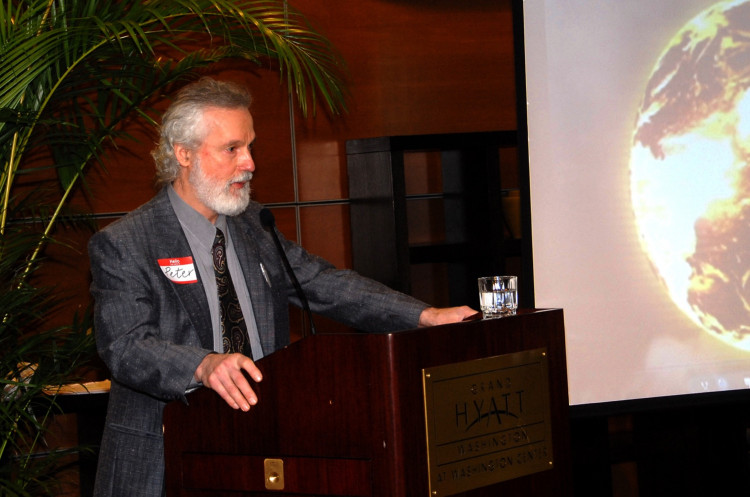
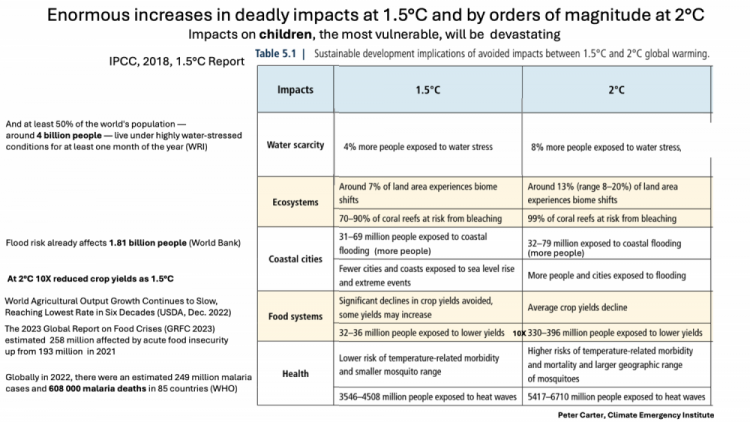
Introduction